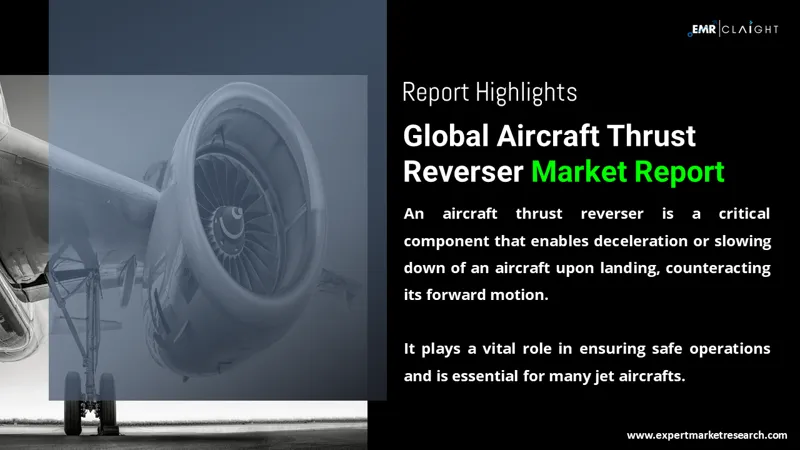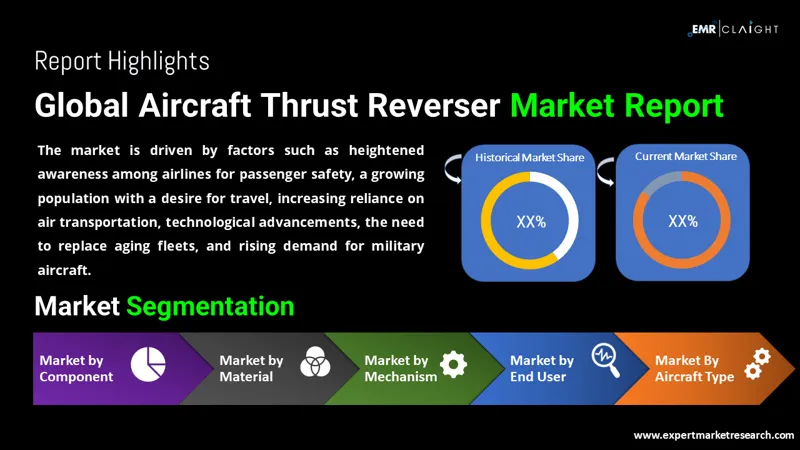
Consumer Insights
Uncover trends and behaviors shaping consumer choices today
Procurement Insights
Optimize your sourcing strategy with key market data
Industry Stats
Stay ahead with the latest trends and market analysis.
The global aircraft thrust reverser market is being aided by the growing aircraft nacelle and thrust reverser market, which attained a value of USD 2.95 Billion in 2025. The aircraft nacelle and thrust reverser market is further expected to grow at a CAGR of 5.00% in the forecast period of 2026-2035 reaching a value of USD 4.81 Billion by 2035.
Base Year
Historical Period
Forecast Period
Compound Annual Growth Rate
5%
Value in USD Billion
2026-2035
*this image is indicative*
Based on aircraft type, commercial aircrafts account for a significant share in the market owing to the rising travel and tourism market, which is likely to propel the number of air passengers every year. The growing charm among youth to travel to various exotic destinations will further propel the demand for commercial aircrafts. Meanwhile, the demand for military aircraft is also expected to be significant owing to the increasing demand in developing economies to protect their sovereignty and enhance defence capabilities.On the basis of end use, the OEM segment accounts for a significant share in the market. This can be attributed to the responsibility of OEM for the installation of thrust reverser components. Also, after the delivery of aircraft, it is hard to make further modifications.

Read more about this report - REQUEST FREE SAMPLE COPY IN PDF
On the basis of material, aluminium alloys account for a significant share in the market and are expected to lead the market in the forecast period as well, owing to the strength and higher temperature enduring capacity of the material. Commercial aircrafts such as Boeing 747 is known to be an aluminium airplane.
High demand for new aircrafts, buttressed by latest innovation and technological features, and the growing need for replacement of aging fleets has bolstered the North America aircraft thrust reverser market growth. This factor is likely to make the North American market quite dominant in the forecast period. Meanwhile, the modernisation programmes in the Asia Pacific aviation sector are expected to aid the market growth in the region.

Read more about this report - REQUEST FREE SAMPLE COPY IN PDF
An aircraft thrust reverser is a component of an aircraft that allows it to it decelerate or slow down just after touchdown. A thrust reverser basically acts against the forward travel of an aircraft. It is a critical component of many jet aircrafts and are considered important for safe operations by airlines.
Market Breakup by Component
Market Breakup by Material
Market Breakup by Mechanism
Market Breakup by End User
Market Breakup by Aircraft Type
Market Breakup by Region
The stringent regulations by the government and the growing awareness among the airline companies about the safety and security of passengers are the major factors driving the market growth in the historical period. However, the COVID-19 virus hampered the market significantly, but the market growth is likely to be propelled by the rising population and the growing enthusiasm among people to travel and explore. The market is anticipated to be aided by the increasing shift towards air transportation, which, in turn, is expected to accelerate the demand for commercial aircrafts. This factor will further bolster the market recovery from the adverse impact of COVID-19 in the forecast period.
The report gives a detailed analysis of the following key players in the global aircraft thrust reverser market, covering their competitive landscape, capacity, and latest developments like mergers, acquisitions, and investments, expansions of capacity, and plant turnarounds:
The comprehensive EMR report provides an in-depth assessment of the market based on the Porter's five forces model along with giving a SWOT analysis.




*While we strive to always give you current and accurate information, the numbers depicted on the website are indicative and may differ from the actual numbers in the main report. At Expert Market Research, we aim to bring you the latest insights and trends in the market. Using our analyses and forecasts, stakeholders can understand the market dynamics, navigate challenges, and capitalize on opportunities to make data-driven strategic decisions.*
Get in touch with us for a customized solution tailored to your unique requirements and save upto 35%!
The global aircraft thrust reverser market is being aided by the growing aircraft nacelle and thrust reverser market, which attained a value of USD 2.95 Billion in 2025.
The global aircraft thrust reverser market is being aided by the growing aircraft nacelle and thrust reverser market, which is further expected to grow at a CAGR of 5.00% in the forecast period of 2026-2035.
The major drivers of the market include the growing awareness among the airline companies about the safety and security of passengers, rising population, growing enthusiasm among people to travel and explore, increasing shift towards air transportation, latest innovation and technological features, growing need for replacement of aging fleets, and increasing demand for military aircraft.
The growing commercial aircraft market and stringent regulations by the government are the key trends propelling the market growth.
The major regions in the market are North America, Latin America, the Middle East and Africa, Europe, and the Asia Pacific.
Based on component, the market is divided into engine cowl, fan cowl, and thrust reverser.
By material, the market can be segmented into composites, metals, aluminium alloys, titanium alloys, nickel chromium, and stainless steel, among others.
On the basis of mechanism, the market can be segmented into hydraulic and electrical.
The end uses are OEM and MRO.
On the basis of aircraft type, the market can be categorised into commercial, business jet, and military aircraft.
The major players in the market are Safran, FACC AG, Collins Aerospace, and Woodward Inc, among others.
Explore our key highlights of the report and gain a concise overview of key findings, trends, and actionable insights that will empower your strategic decisions.
| REPORT FEATURES | DETAILS |
| Base Year | 2025 |
| Historical Period | 2019-2025 |
| Forecast Period | 2026-2035 |
| Scope of the Report |
Historical and Forecast Trends, Industry Drivers and Constraints, Historical and Forecast Market Analysis by Segment:
|
| Breakup by Component |
|
| Breakup by Material |
|
| Breakup by Mechanism |
|
| Breakup by End User |
|
| Breakup by Aircraft Type |
|
| Breakup by Region |
|
| Market Dynamics |
|
| Competitive Landscape |
|
| Companies Covered |
|
| Report Price and Purchase Option | Explore our purchase options that are best suited to your resources and industry needs. |
| Delivery Format | Delivered as an attached PDF and Excel through email, with an option of receiving an editable PPT, according to the purchase option. |
Datasheet
One User
USD 2,499
USD 2,249
tax inclusive*
Single User License
One User
USD 3,999
USD 3,599
tax inclusive*
Five User License
Five User
USD 4,999
USD 4,249
tax inclusive*
Corporate License
Unlimited Users
USD 5,999
USD 5,099
tax inclusive*
*Please note that the prices mentioned below are starting prices for each bundle type. Kindly contact our team for further details.*
Flash Bundle
Small Business Bundle
Growth Bundle
Enterprise Bundle
*Please note that the prices mentioned below are starting prices for each bundle type. Kindly contact our team for further details.*
Flash Bundle
Number of Reports: 3
20%
tax inclusive*
Small Business Bundle
Number of Reports: 5
25%
tax inclusive*
Growth Bundle
Number of Reports: 8
30%
tax inclusive*
Enterprise Bundle
Number of Reports: 10
35%
tax inclusive*
How To Order

Select License Type
Choose the right license for your needs and access rights.

Click on ‘Buy Now’
Add the report to your cart with one click and proceed to register.

Select Mode of Payment
Choose a payment option for a secure checkout. You will be redirected accordingly.
Gain insights to stay ahead and seize opportunities.

Get insights & trends for a competitive edge.

Track prices with detailed trend reports.

Analyse trade data for supply chain insights.

Leverage cost reports for smart savings

Enhance supply chain with partnerships.

Connect For More Information
Our expert team of analysts will offer full support and resolve any queries regarding the report, before and after the purchase.
Our expert team of analysts will offer full support and resolve any queries regarding the report, before and after the purchase.
We employ meticulous research methods, blending advanced analytics and expert insights to deliver accurate, actionable industry intelligence, staying ahead of competitors.
Our skilled analysts offer unparalleled competitive advantage with detailed insights on current and emerging markets, ensuring your strategic edge.
We offer an in-depth yet simplified presentation of industry insights and analysis to meet your specific requirements effectively.
Share